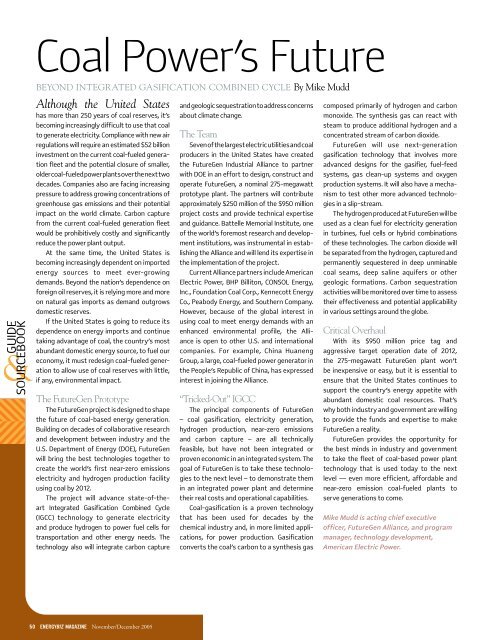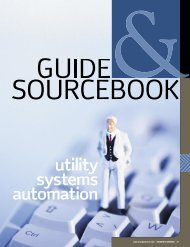generation technologies
generation technologies
generation technologies
You also want an ePaper? Increase the reach of your titles
YUMPU automatically turns print PDFs into web optimized ePapers that Google loves.
Coal Power’s Future<br />
BEYONd INTEGRATEd GASIFICATION COmBINEd CYClE By mike mudd<br />
Although the United States<br />
has more than 250 years of coal reserves, it’s<br />
becoming increasingly difficult to use that coal<br />
to generate electricity. Compliance with new air<br />
regulations will require an estimated $52 billion<br />
investment on the current coal-fueled <strong>generation</strong><br />
fleet and the potential closure of smaller,<br />
older coal-fueled power plants over the next two<br />
decades. Companies also are facing increasing<br />
pressure to address growing concentrations of<br />
greenhouse gas emissions and their potential<br />
impact on the world climate. Carbon capture<br />
from the current coal-fueled <strong>generation</strong> fleet<br />
would be prohibitively costly and significantly<br />
reduce the power plant output.<br />
At the same time, the United States is<br />
becoming increasingly dependent on imported<br />
energy sources to meet ever-growing<br />
demands. Beyond the nation’s dependence on<br />
foreign oil reserves, it is relying more and more<br />
on natural gas imports as demand outgrows<br />
domestic reserves.<br />
If the United States is going to reduce its<br />
dependence on energy imports and continue<br />
taking advantage of coal, the country’s most<br />
abundant domestic energy source, to fuel our<br />
economy, it must redesign coal-fueled <strong>generation</strong><br />
to allow use of coal reserves with little,<br />
if any, environmental impact.<br />
The FutureGen Prototype<br />
The FutureGen project is designed to shape<br />
the future of coal-based energy <strong>generation</strong>.<br />
Building on decades of collaborative research<br />
and development between industry and the<br />
U.S. Department of Energy (DOE), FutureGen<br />
will bring the best <strong>technologies</strong> together to<br />
create the world’s first near-zero emissions<br />
electricity and hydrogen production facility<br />
using coal by 2012.<br />
The project will advance state-of-theart<br />
Integrated Gasification Combined Cycle<br />
(IGCC) technology to generate electricity<br />
and produce hydrogen to power fuel cells for<br />
transportation and other energy needs. The<br />
technology also will integrate carbon capture<br />
50 EnErgyBiz magazinE November/December 2005<br />
and geologic sequestration to address concerns<br />
about climate change.<br />
The Team<br />
Seven of the largest electric utilities and coal<br />
producers in the United States have created<br />
the FutureGen Industrial Alliance to partner<br />
with DOE in an effort to design, construct and<br />
operate FutureGen, a nominal 275-megawatt<br />
prototype plant. The partners will contribute<br />
approximately $250 million of the $950 million<br />
project costs and provide technical expertise<br />
and guidance. Battelle Memorial Institute, one<br />
of the world’s foremost research and development<br />
institutions, was instrumental in establishing<br />
the Alliance and will lend its expertise in<br />
the implementation of the project.<br />
Current Alliance partners include American<br />
Electric Power, BHP Billiton, CONSOL Energy,<br />
Inc., Foundation Coal Corp., Kennecott Energy<br />
Co., Peabody Energy, and Southern Company.<br />
However, because of the global interest in<br />
using coal to meet energy demands with an<br />
enhanced environmental profile, the Alliance<br />
is open to other U.S. and international<br />
companies. For example, China Huaneng<br />
Group, a large, coal-fueled power generator in<br />
the People’s Republic of China, has expressed<br />
interest in joining the Alliance.<br />
“Tricked-Out” IGCC<br />
The principal components of FutureGen<br />
– coal gasification, electricity <strong>generation</strong>,<br />
hydrogen production, near-zero emissions<br />
and carbon capture – are all technically<br />
feasible, but have not been integrated or<br />
proven economic in an integrated system. The<br />
goal of FutureGen is to take these <strong>technologies</strong><br />
to the next level – to demonstrate them<br />
in an integrated power plant and determine<br />
their real costs and operational capabilities.<br />
Coal-gasification is a proven technology<br />
that has been used for decades by the<br />
chemical industry and, in more limited applications,<br />
for power production. Gasification<br />
converts the coal’s carbon to a synthesis gas<br />
composed primarily of hydrogen and carbon<br />
monoxide. The synthesis gas can react with<br />
steam to produce additional hydrogen and a<br />
concentrated stream of carbon dioxide.<br />
FutureGen will use next-<strong>generation</strong><br />
gasification technology that involves more<br />
advanced designs for the gasifier, fuel-feed<br />
systems, gas clean-up systems and oxygen<br />
production systems. It will also have a mechanism<br />
to test other more advanced <strong>technologies</strong><br />
in a slip-stream.<br />
The hydrogen produced at FutureGen will be<br />
used as a clean fuel for electricity <strong>generation</strong><br />
in turbines, fuel cells or hybrid combinations<br />
of these <strong>technologies</strong>. The carbon dioxide will<br />
be separated from the hydrogen, captured and<br />
permanently sequestered in deep unminable<br />
coal seams, deep saline aquifers or other<br />
geologic formations. Carbon sequestration<br />
activities will be monitored over time to assess<br />
their effectiveness and potential applicability<br />
in various settings around the globe.<br />
Critical Overhaul<br />
With its $950 million price tag and<br />
aggressive target operation date of 2012,<br />
the 275-megawatt FutureGen plant won’t<br />
be inexpensive or easy, but it is essential to<br />
ensure that the United States continues to<br />
support the country’s energy appetite with<br />
abundant domestic coal resources. That’s<br />
why both industry and government are willing<br />
to provide the funds and expertise to make<br />
FutureGen a reality.<br />
FutureGen provides the opportunity for<br />
the best minds in industry and government<br />
to take the fleet of coal-based power plant<br />
technology that is used today to the next<br />
level — even more efficient, affordable and<br />
near-zero emission coal-fueled plants to<br />
serve <strong>generation</strong>s to come.<br />
Mike Mudd is acting chief executive<br />
officer, FutureGen Alliance, and program<br />
manager, technology development,<br />
American Electric Power.















![View From the Trenches [PDF]](https://img.yumpu.com/18854438/1/190x252/view-from-the-trenches-pdf.jpg?quality=85)
